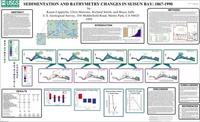Sedimentation and bathymetry changes in Suisun Bay: 1867-1990
Links
- More information: USGS Index Page (html)
- Plate: Of99 563 (pdf)
- Companion File: Companion Files
- Download citation as: RIS | Dublin Core
Abstract
Understanding patterns of historical erosion and deposition in San Francisco Bay is crucial in managing such issues as locating deposits of sediment-associated contaminants, and the restoration of wetland areas. These problems were addressed by quantitatively examining historical hydrographic surveys. The data from five hydrographic surveys, made from 1867 to 1990, were analyzed using surface modeling software to determine long-term changes in the sediment system of Suisun Bay and surrounding areas. A surface grid displaying the bathymetry was created for each survey period, and the bathymetric change between survey periods was computed by differencing these grids. Patterns and volumes of erosion and deposition, sedimentation rates, and shoreline changes were derived from the resulting change grids. Approximately 115 million cubic meters of sediment were deposited in the Suisun Bay area from 1867 to 1887, the majority of which was debris from hydraulic gold mining in the Sierra Nevada. Just under two-thirds of the area of the study site was depositional during this time period, while less than one-third of it was erosional. However, over the entire study period, the Suisun Bay area lost sediment, indicating that a large amount of erosion occurred from1887 to 1990. In fact, this area lost sediment during each of the change periods between 1887 and 1990. Because erosion and deposition are processes that may vary over space and time, further analyses of more specific areas were done to examine spatial and temporal patterns. The change in the Suisun Bay area from being a largely depositional environment to an erosional one is the result of a combination of several factors. These factors include the regulation and subsequent cessation of hydraulic mining practices, and the increase in flood control and water distribution projects that have decreased sediment supply to the bay by reducing the frequency and duration of peak flow conditions. Another pattern shown by the changing bathymetry is the substantial decrease in the area of tidal flat (defined in this study as the area between mean lower low water and the shoreline), particularly in Grizzly Bay and Honker Bay. These tidal flats are important to the bay ecosystem, providing stability and biologic diversity.
Study Area
| Publication type | Report |
|---|---|
| Publication Subtype | USGS Numbered Series |
| Title | Sedimentation and bathymetry changes in Suisun Bay: 1867-1990 |
| Series title | Open-File Report |
| Series number | 99-563 |
| DOI | 10.3133/ofr99563 |
| Year Published | 1999 |
| Language | English |
| Publisher | U.S. Geological Survey |
| Contributing office(s) | San Francisco Bay-Delta, Pacific Regional Director's Office |
| Description | Report: 48.76 x 30.10 inches; Report: PostScript file |
| Country | United States |
| State | California |
| Other Geospatial | Grizzly Bay;Honker Bay;San Francisco Bay;Sierra Nevada;Suisun Bay |
| Online Only (Y/N) | N |
| Additional Online Files (Y/N) | Y |


